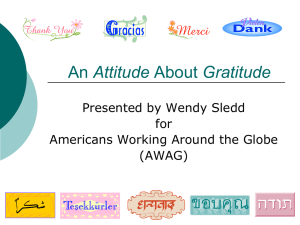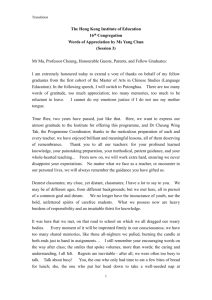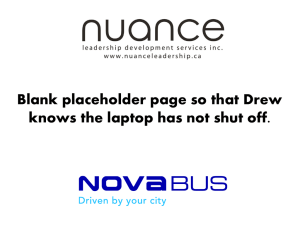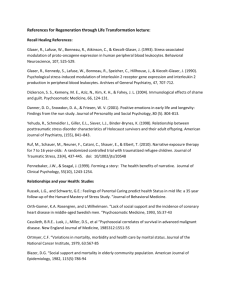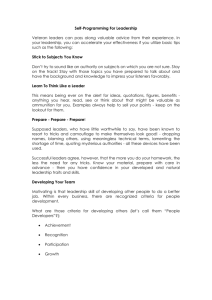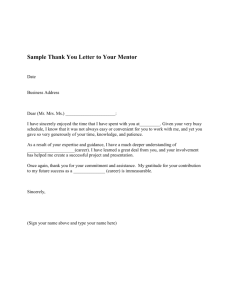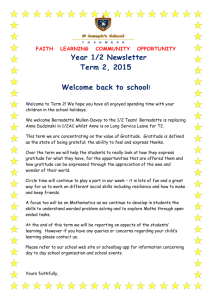Communication Matters - Institute for Healthcare Communication
advertisement
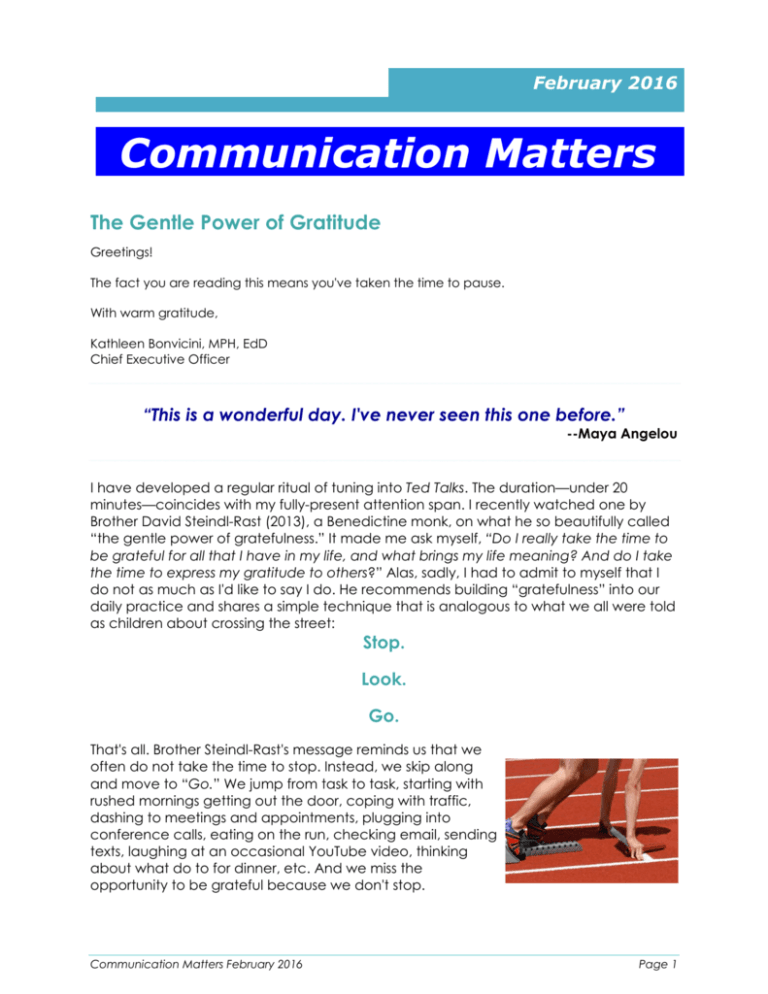
February 2016 Communication Matters The Gentle Power of Gratitude Greetings! The fact you are reading this means you've taken the time to pause. With warm gratitude, Kathleen Bonvicini, MPH, EdD Chief Executive Officer “This is a wonderful day. I've never seen this one before.” --Maya Angelou I have developed a regular ritual of tuning into Ted Talks. The duration—under 20 minutes—coincides with my fully-present attention span. I recently watched one by Brother David Steindl-Rast (2013), a Benedictine monk, on what he so beautifully called “the gentle power of gratefulness.” It made me ask myself, “Do I really take the time to be grateful for all that I have in my life, and what brings my life meaning? And do I take the time to express my gratitude to others?” Alas, sadly, I had to admit to myself that I do not as much as I'd like to say I do. He recommends building “gratefulness” into our daily practice and shares a simple technique that is analogous to what we all were told as children about crossing the street: Stop. Look. Go. That's all. Brother Steindl-Rast's message reminds us that we often do not take the time to stop. Instead, we skip along and move to “Go.” We jump from task to task, starting with rushed mornings getting out the door, coping with traffic, dashing to meetings and appointments, plugging into conference calls, eating on the run, checking email, sending texts, laughing at an occasional YouTube video, thinking about what do to for dinner, etc. And we miss the opportunity to be grateful because we don't stop. Communication Matters February 2016 Page 1 Taking time to pause When we stop and get quiet, we have an opportunity to notice something very beautiful that may otherwise fly by. Brother Steindl-Rast calls it “building stop signs into our lives.” I call it “inserting a pause.” The other day, while in my usual rush mode getting ready for work, I stopped and noticed. One of my cats was staring out the sliding glass door into the back yard. Normally, I'd walk by and think nothing of it. Yet this time I crouched down to look out from his point of view and lo and behold! in the distance, I saw a deer sitting and looking right at us. We all sat there together quietly. I felt a peaceful connection, and appreciated the gift of a sense of calm in the midst of a hectic morning. In that moment I was reminded about what I miss when I don't take the time to pause. Accentuating the positive brings benefits Much has been written about gratitude and its association with overall well-being. Gratitude has a number of meanings: It has been conceptualized as a virtue, an attitude, an emotion and a coping response (Lambert, 2009). It has also been defined broadly as “the appreciation of what is valuable and meaningful... and represents a state of thankfulness and/or appreciation” (Sansone & Sonsone, 2010). According to University of California-Davis researcher Robert Emmons, the practice of gratitude has shown to lower blood pressure, improve immune function, and facilitate more efficient sleep (Emmons, 2003; Hart 2013). When we take time to feel gratitude, we acknowledge what is good in our lives. The source of that goodness lies within us and partially outside of us through other people, in nature or even in a higher power. Expressing gratitude helps us to better connect with people in our lives, our family, loved ones, friends, coworkers, our patients and/or clients, etc. Yet, how often do we express our gratitude when a person's actions have influenced us in some positive way? When we express gratitude toward others, we let them know how they have contributed and how their behavior has touched us. The need for appreciation is fundamental to satisfying personal and professional relationships. Sharing your gratitude verbally is feedback which promotes connection and strengthens relationships. Communication Matters February 2016 Page 2 Gratitude and feedback What is the relationship between the expression of gratitude and feedback? You may have heard the expression “Feedback is a gift” and silently wondered, “Really?” We invite you to consider this: When we express gratitude, we are celebrating via feedback how we have been enriched by another person's actions. While the intention for sharing gratitude is often pure appreciation, the delivery may be diluted with praise and compliments tied to externally driven rewards. Our culture often trains us to contribute for extrinsic reasons: rewards, approval from others, a bonus, name recognition, etc. Our language as we express gratitude may unintentionally undermine the intent with a focus on external approval. When we say “Good job!” we leave the other person dependent on our opinion of what a good job is and, potentially, unsure about what was good about their work. It provides little information other than that his or her actions are appreciated. The verbal expression of gratitude is ever more meaningful when done with sincerity and attention to the “what” and “impact” of what was done and for which you are thankful. By paying attention to our language, our expressions of appreciation can be abundantly useful to the recipient. A few direct and factual statements can contribute to their knowledge base and, significantly, their capacity to contribute effectively. Ways to express gratitude The next time you want to extend your gratitude to someone, consider adding one or both of the following components in your feedback. Here's an example in the workplace: 1. State what the person did, in descriptive terms: “Susan, I want to talk to you about the discussion you led at the morning meeting. I noticed how you really took the time to listen to everyone's point of view, you went around the room and checked in with all of us, and you handled the questions calmly and directly.” 2. Express your feelings, thoughts and/or needs that were met: “I felt comfortable sharing my opinion and I wanted to let you know how much I really appreciated how you handled the meeting. Thanks.” In this workplace example of expressing gratitude, Susan will come away with more details to help her understand how she contributed; and a deepened professional connection. Contrast this with, “Good job at the meeting this morning.” Communication Matters February 2016 Page 3 Ways to receive gratitude How about when we are on the receiving end of feedback that is an expression of gratitude? When we receive gratitude, we have the opportunity to continue the connection loop by saying, “I'm glad I was able to share something that is useful for you.” If, instead, after receiving gratitude feedback we say “Oh, it's nothing,” or “No problem,” we inadvertently break the feedback connection loop and lose some of the positive energy that was generated. If we want to be brief, instead of “It's nothing,” try “My pleasure.” The exact choice of words is less important than honoring the intent and maintaining the connection. We invite you to try out one or more of the simple techniques noted to explore the gentle power of gratitude. Let us know how it works for you! Works Cited Emmons RA, McCullough ME. (2003). Counting your blessings versus burdens: An experimental investigation of gratitude and subjective well-being in daily life. J Pers Soc Psychol; 84:377-389. Hart J (2013). Practicing gratitude linked to better health. Alternative and Complementary Therapies, 19(6): 323-325. Lambert NM (2009), Graham SM, Fincham FD. A prototype analysis of gratitude: varieties of gratitude experiences. Pers Soc Psychol Bull 35:1193-1207. Sansone RA, & Sansone LA (2010). Gratitude and well-being: The benefits of appreciation. Psychiatry 7(11):18-22. Steindl-Rast D. (2013, June). Brother David Steindl-Rast. Want to be happy? Be grateful. [Video file]. Retrieved from https://www.ted.com/talks/david_steindl_rast_want_to_be_happy_be_grateful?language=en Institute for Healthcare Communication 171 Orange Street, 2R New Haven, CT 06510-3111 (800) 800-5907 info@healthcarecomm.org www.healthcarecomm.org Communication Matters February 2016 Page 4
